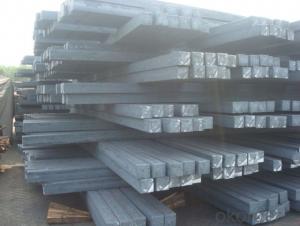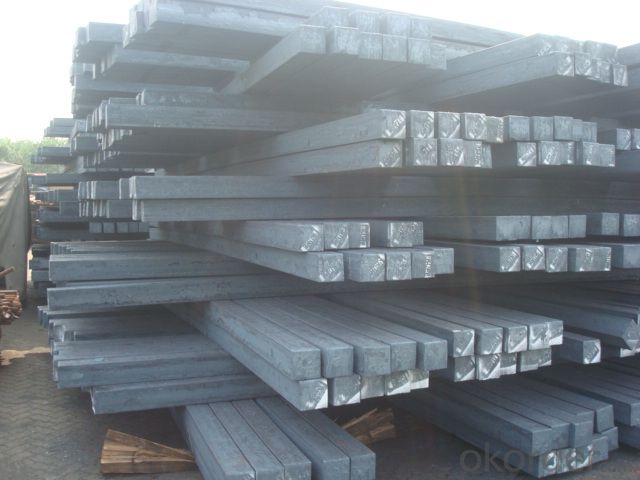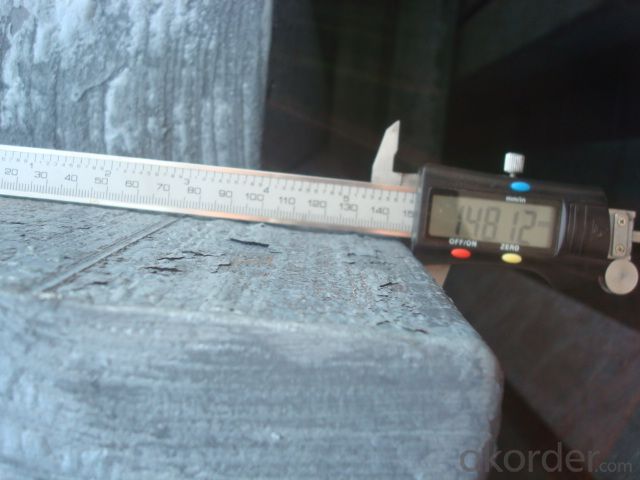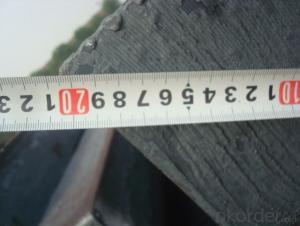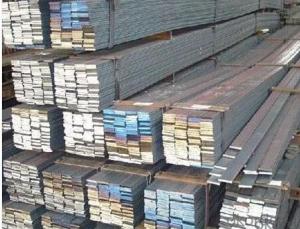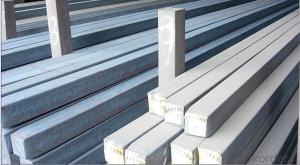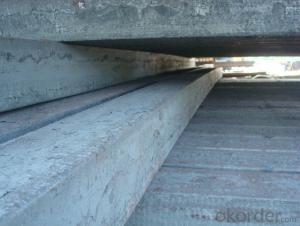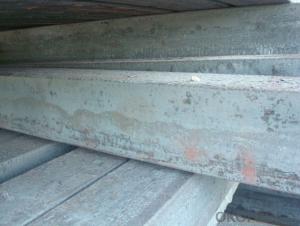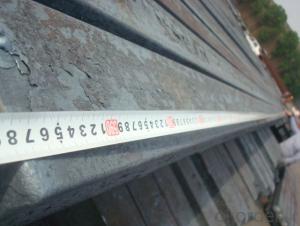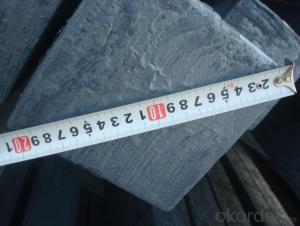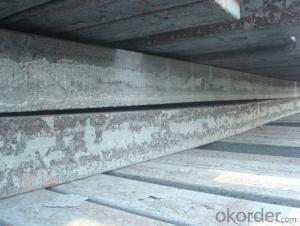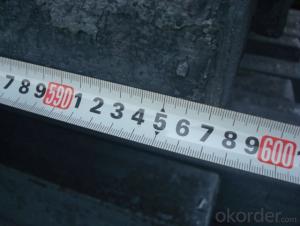Continue Casting Steel Bloom by Blast Furnace Q235
- Loading Port:
- Tianjin
- Payment Terms:
- TT OR LC
- Min Order Qty:
- 1000 m.t.
- Supply Capability:
- 100000 m.t./month
OKorder Service Pledge
OKorder Financial Service
You Might Also Like
Continue Casting Steel Bloom by Blast Furnace Q235
1.Structure of Continue Casting Steel Bloom by Blast Furnace Q235
Continue Casting Steel Bloom by Blast Furnace Q235 the raw material of all kinds of steel mill. Billet section of square, round, flat, rectangular and abnormity, etc Several, mainly related to shape of rolled products. Simple rolled section steel, choose cross section of square billet or rectangular billet. rolling The sector products such as flat steel, Angle steel, select the rectangular billet or slab. Had better profiled billet when production beams, channels, and in rolling process Lines and improve the yield. The raw material of round billet is the production of seamless tube.
2.Main Features of Continue Casting Steel Bloom by Blast Furnace Q235
Continue Casting Steel Bloom by Blast Furnace Q235section size should meet the requirements of rolling deformation and finished product quality, but also roll strength and biting condition of restrictions. General steel Billet section height H. And the roll diameter D The ratio of the ( namely H/D) Should be less than or equal to zero 0.5 . Length of steel billet by finishing temperature, Rolling time and the length of the product Or times ruler. When heated too long accident prone to bump the furnace wall of steel, too short, furnace bottom utilization rate is not high, influence the heating furnace production. For the production Choose a variety of steel and steel billet, should consider the affinities of billet, as far as possible in order to improve the productivity of the roughing mill, simplify the stock management of workshop.
3. Continue Casting Steel Bloom by Blast Furnace Q235 Images
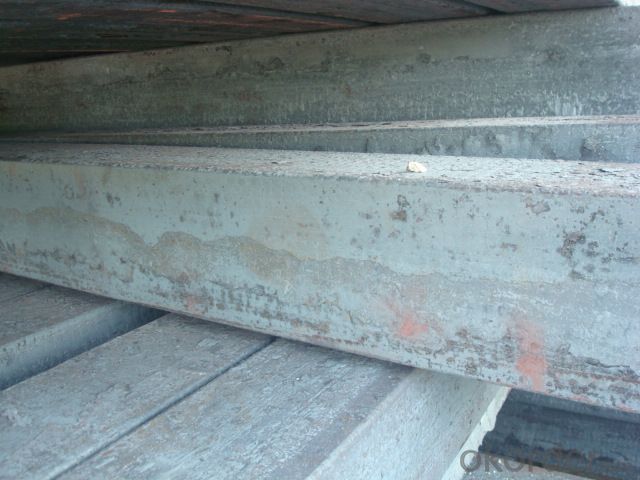
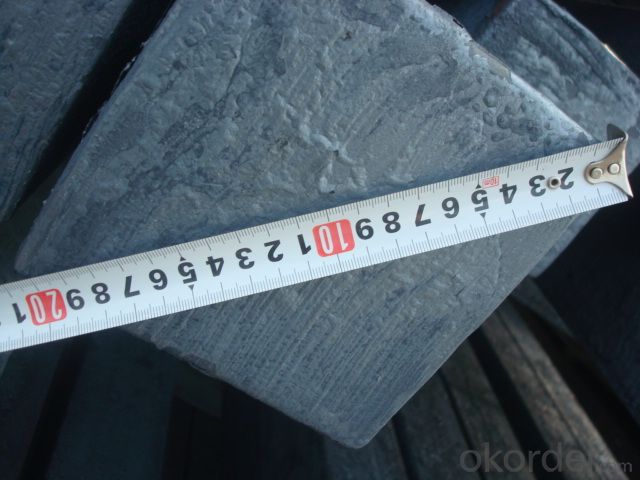
4. Continue Casting Steel Bloom by Blast Furnace Q235 Specification
Continue Casting Steel Bloom by Blast Furnace rolled steel, after processing can be used for mechanical parts, forging parts, processing all kinds of steel, steel Q345B channel steel, wire rod is the role of the billet. Steel billet is used in the production of semi-finished products, generally cannot be used directly for the society. Steel billets and steel are strictly divided into standard, cannot decide to whether the business enterprise of the final product, and according to unified standards to perform the whole society. Typically, billet and the steel is relatively easy to distinguish, but for some steel billet, and have the same specification and same steel purposes (such as rolling tube billet), whether can be used for other industries, whether through steel processing process, whether through a finished product rolling mill processing to distinguish
Material standard The editor Range of thickness: 150-240 - mm + / - 5 mm width range: 880-1530 - mm + / - 20 mm Length: 3700-10000 - mm + / - 500 - mm Cross-sectional size: 64 * 64; 82 * 82; 98 * 98; 124 * 124; 120 * 150; 152 * 164; 152 * 170 mm Length: 9000 mm Section of tolerance: billet: 1.0 + / - 2.0-1.0 + / - 1.0 mm slab: width: + / - 2.0 mm thickness: + / - 3.0 mm The length tolerance: + / - 200 mm Section diagonal tolerance: 3.5-8.0 MM Billet section size protrusions requirements: < 1242 mm, do not allow; > = 1242 mm, < = 2 mm 1242 mm, < = 3 mm Beheading (shear) extension deformation: < 1242 mm billet: no control; The slab: < = 15 mm Surface tilt: no more than billet section 0.1 Bending: every 1 m length is not more than 10 mm The distortion: length < = 5 m, < = 11. ; The length of the < = 7.5 M, < = 5. Material % 3 sp/PS chemical composition: C Mn Si S P
Q235A: C:0.14-0.22%, Mn: 0.3-0.65%, Si: max 0.3%, S:MAX 0.045% P:MAX 0.045%
Q235B: C:0.12-0.2%, Mn: 0.3-0.7%, Si: max 0.3%, S:MAX 0.045% P:MAX 0.045%
Q235C: C:MAX 0.18%, Mn: 0.35-0.8%, Si: max 0.3%, S:MAX 0.04% P:MAX 0.045%
Q235D: C:MAX 0.17%, Mn: 0.35-0.8%, Si: max 0.3%, S:MAX 0.035% P:MAX 0.035%
For diffirent usage, can add some other chemical compositions.
5.FAQ of Continue Casting Steel Bloom by Blast Furnace Q235
We have organized several common questions for our clients,may help you sincerely:
①How to make the contract for the long term business?
Because the steel billet price is changing according to the market price changing every day, so we could't make a long term business contract with our customer.
②How to guarantee the quality of the products?
We have established the international advanced quality management system,every link from raw material to final product we have strict quality test;We resolutely put an end to unqualified products flowing into the market. At the same time, we will provide necessary follow-up service assurance.
And you can employ the third party inspecting company to check and get the report from them dirrectly or you can pay and then we can arrange for you before loading.And if you have any feedback about the quality you can tell us in the first time.
③Except the Q235, are there any other grades we can order?
Yes, there are, you can choose and then we do that for you, for example Q195/215/275 or you can give us the chemical composition and then we make for you.
- Q: How are steel billets used in the production of heat exchangers?
- Steel billets are an essential component in the production of heat exchangers. Heat exchangers are devices that transfer heat between two or more fluids, such as air and water, without them coming into direct contact. Steel billets, which are semi-finished metal products, serve as the raw material for manufacturing the various components of heat exchangers. Firstly, steel billets are used to create the tubes and pipes that form the primary framework of heat exchangers. These tubes are designed to withstand high pressures and temperatures while efficiently transferring heat. Steel, with its high strength and thermal conductivity, is an ideal material for this purpose. Next, the steel billets are processed through various techniques such as hot rolling, forging, or extrusion to shape them into the required dimensions. This process ensures that the tubes and pipes have the desired diameter, thickness, and length, which are crucial factors in determining the heat transfer efficiency of the heat exchanger. Additionally, steel billets are also used to produce the fins and plates of heat exchangers. Fins are thin, elongated structures that increase the surface area of the heat exchanger, allowing for enhanced heat transfer. Steel billets are shaped and cut into fins, which are then attached to the tubes or plates. These fins provide additional contact points for heat transfer and help improve the overall efficiency of the heat exchanger. Moreover, steel billets are used in the production of headers and manifolds, which are crucial components for the distribution and collection of fluids within the heat exchanger. These headers ensure that the fluids flow through the tubes and fins in a controlled manner, maximizing heat transfer and minimizing pressure losses. The strength and durability of steel make it a suitable material for these critical components. In conclusion, steel billets play a vital role in the production of heat exchangers. They are used to manufacture the tubes, pipes, fins, headers, and manifolds, which are all essential components of a heat exchanger. The use of steel ensures the durability, strength, and thermal conductivity required for efficient heat transfer in these devices.
- Q: How are steel billets used in the manufacturing of construction machinery parts?
- Steel billets are used in the manufacturing of construction machinery parts as the starting material for forging, casting, or machining processes. They are heated and shaped into various components such as gears, shafts, frames, and structural elements, providing the necessary strength, durability, and precision required for construction machinery.
- Q: the ear has burrs, is it the billet problem or the rolling mill problem, will it be caused by the blowhole of the billet?
- The rolling process of rolling mill of hot rolling and cold rolling process for the two step: a hot rolling process: from out of billet steel plant is only semi-finished products, to the rolling mill for rolling, in order to become a qualified product.
- Q: Are steel billets prone to corrosion?
- Yes, steel billets are prone to corrosion. Steel is primarily made from iron, and iron is susceptible to rusting and oxidation when exposed to moisture and oxygen. Therefore, steel billets, which are the raw form of steel used for further processing, can corrode if not properly protected or maintained.
- Q: Refinery carbon 3 is propane, then carbon four carbon five is what name ah?.What are they used for?
- Carbon four is butane, C4H10 carbon five is pentane C5H12
- Q: What are the common quality control measures for steel billets?
- Common quality control measures for steel billets include: 1. Dimensional checks: This involves measuring the length, width, and thickness of the billets to ensure they meet the specified tolerances. Any deviations from the required dimensions can indicate a potential quality issue. 2. Visual inspection: Billets are visually inspected to identify any surface defects such as cracks, scratches, or dents. This is typically done using visual aids like magnifying glasses or cameras to ensure the surface is free from any imperfections. 3. Chemical composition analysis: A sample is taken from the billet and analyzed to determine its chemical composition. This is important as it ensures that the steel meets the specified requirements in terms of the percentage of different elements, such as carbon, manganese, and sulfur. Deviations from the desired composition can affect the steel's strength and other properties. 4. Mechanical testing: Various mechanical tests are conducted on the billets to assess their strength, ductility, and other mechanical properties. These tests may include tensile testing, hardness testing, impact testing, and bend testing. The results are compared to the specified standards to ensure the billets meet the required mechanical properties. 5. Ultrasonic testing: This non-destructive testing method is used to detect internal defects or irregularities within the billets. Ultrasonic waves are sent through the billet, and any reflected waves or changes in wave patterns can indicate the presence of defects such as voids, inclusions, or cracks. 6. Heat treatment verification: Steel billets often undergo heat treatment processes to enhance their properties. Quality control measures involve verifying that the billets have been properly heat treated by conducting tests such as hardness testing or microstructure analysis. 7. Surface finish inspection: The surface finish of the billets is checked to ensure it meets the specified requirements. This can include measuring the surface roughness or visually inspecting for any deviations from the desired finish, such as scale, rust, or uneven surfaces. By implementing these quality control measures, steel manufacturers can ensure that the billets they produce meet the required standards and specifications, leading to high-quality end products.
- Q: How are steel billets used in the production of crankshafts?
- Steel billets are used in the production of crankshafts as they serve as the raw material that is shaped and machined to form the main body of the crankshaft. These billets are heated, forged, and then machined to create the precise shape and dimensions required for the crankshaft. This process ensures the strength, durability, and performance of the crankshaft in engines.
- Q: How do steel billets come out?
- Two, pig iron and scrap steel1, smelting equipmentA, BOF: top and bottom blowing, blowing, now is widely used in pure oxygen top blown converterB, open hearth:C, electric steelmaking:
- Q: How are steel billets used in the manufacturing of electrical transmission equipment?
- Steel billets are often used as raw material in the manufacturing of electrical transmission equipment. They are typically forged or machined to create various components such as brackets, supports, and housings. These billets provide the necessary strength, durability, and dimensional stability required for the equipment to withstand high electrical loads and harsh operating conditions.
- Q: What are the different methods of steel billet cutting?
- There are several common methods for cutting steel billets, including sawing, shearing, abrasive cutting, and flame/plasma cutting. Sawing involves using a high-speed circular saw blade to cut through the billet, while shearing involves using a guillotine-like tool to apply a shearing force and cut the billet. Abrasive cutting utilizes a high-speed abrasive wheel to grind through the steel, and flame or plasma cutting involves using a focused flame or plasma arc to melt and cut the billet. Each method has its own advantages and disadvantages depending on the specific requirements of the project.
Send your message to us
Continue Casting Steel Bloom by Blast Furnace Q235
- Loading Port:
- Tianjin
- Payment Terms:
- TT OR LC
- Min Order Qty:
- 1000 m.t.
- Supply Capability:
- 100000 m.t./month
OKorder Service Pledge
OKorder Financial Service
Similar products
Hot products
Hot Searches
Related keywords
